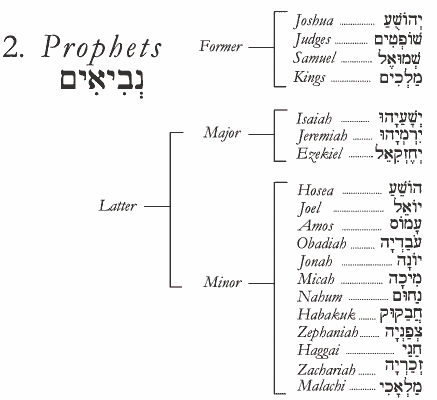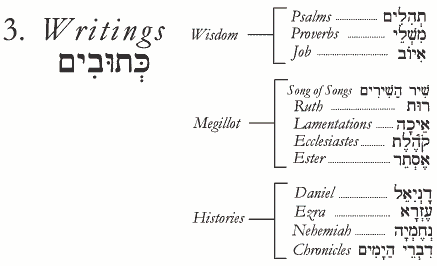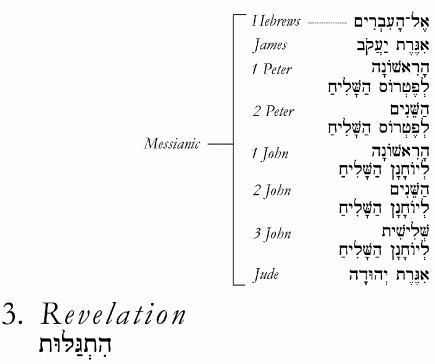|
|
 |
 |
|
The Hebrew Scriptures -
|
|
|
|
 |
 |
 |
|
Kitvei HaKodesh - כִּתְבֵי הַקּדֶשׁ
|
|
|
|
The Hebrew Bible is called the Tanakh (sometimes transliterated as Tanach in English), an acronym for Torah, Nevi'im, and Ketuvim (note the gerashayim in the Hebrew acronym תנ״ך). The Tanakh is divided into three main sections, as follows:
|
|
|
 |
 |
|
Download a printable document listing the books of the Bible in Hebrew:
|
 |
|
|
|
Torah
(Teaching)
|

|
The first five books of Moses. The actual Torah itself is referred to as the Sefer Torah, or sacred Torah scroll. The Chumash is a book form of the Torah, usually subdivided into 54 smaller literary units called parashiot (the name of each parashah comes from a key word of the section). The word Torah is better understood as "teaching" or "understanding" rather than "law."
(Torah makes the "t" of Tanakh).
|
|
Nevi'im
(Prophets)
|

|
The prophetical books are subdivided into two parts: Four books of the "Former" prophets and 15 books of the "Latter" prophets (Nevi'im makes the "n" of Tanakh).
|
|
Ketuvim
(Writings)
|

|
Assorted sacred writings, including Psalms, Proverbs, and some historical books. There are 12 books in this division of the Tanakh (Ketuvim makes the "k(h)" of Tanakh).
|
|
 |
 |
|
Notes:
|
 |
 |
|
- Some Jews refer to the entire Hebrew Bible (Kitvei HaKodesh) simply as the Torah -- without making the distinction of the divisions shown above.
- Though the Christian Old Testament is the result of the canonization of the Jewish scriptures, the order of the books in the Tanakh is not identical to the Christian Old Testament (though content is the same), and chapter and verse references are not always identical between the Old Testament and the Tanakh.
- Some Jews refer to the Torah and Nakh - referring to the Nevi'im and Ketuvim as separate from written Torah (i.e., Nakh).
- Traditionally, weekly Torah readings (called parashiyot) of the entire Torah are completed during one year. Weekly Nevi'im readings are known as haftarah.
- Most Jews put the Oral Law (Talmud) and the halakhah (Rabbinic rulings) on the same level as the written Torah.
|
 |
 |
 |
 |
|
The Thirteen Principles of Faith
|
|
|
|
Moses Maimonides (1135-1204) is considered by many Jews to be the most important medieval sage. Influenced by Thomas Aquinas and Avicenna, Maimonides sought to systematize the Jewish faith along scholastic lines. His Shloshah-Asar Ikkarim, or Thirteen Principles of the faith, is still widely recited as a sort of Jewish credo among many orthodox Jews.
|
|
|
Related Items:
|
|
 |
|
|
|

|
Tanakh Plus. Bilingual Hebrew-English Bible with concordances and amazing Gematria tools. This software program allows you to do research on the Scriptures that more expensive programs cannot do. It includes a complete Hebrew concordance of the Jewish Bible.
|
Click for details
|
|
 |
|
|
|

|
Transliterated Hebrew Bible. This unique resource goes verse by verse through the Hebrew Bible, listing 1) the Hebrew text, 2) a complete phonetic transliteration, and 3) an English translation. It's like having three Bibles in one! In addition, an accompanying audio CD includes the entire Bible narrated in Hebrew (mp3 format) -- over 65 hours of recording -- that you can use to further reinforce your learning!
|
Click for details
|
|
 |
 |
|
The B'rit Chadashah
|
 |
 |
|
The New Testament is called the B'rit Chadashah in Hebrew (בְּרִית חֲדָשָׁה), meaning "New Covenant" (the word B'rit means "covenant" and Chadashah means "new"). Like the Tanakh, it can be divided into three main parts: Gospels/Acts (corresponding to Torah), Letters (corresponding to Ketuvim), and Revelation (corresponding to Nevi'im):
|
 |
 |
|
Download a printable Word document listing the books of the Bible in Hebrew:
|
 |
 |
|
Like the Tanakh, the B'rit Chadashah can be divided into three main parts: Gospels/Acts (corresponding to Torah), Letters (corresponding to Ketuvim), and Revelation (corresponding to Nevi'im):
|
 |
|
|
|
Besorat HaGe'ulah
[Gospels]
|

|
The four portraits of the Messiah of Israel as given by His messengers (Luke/Acts may be considered as a unit). Besorah means "good news" and Ge'ulah means "redemption."
|
|
Iggerot
[Letters]
|

|
Eight "general" letters to Messianic Jewish communities and thirteen letters from Paul, the emissary to the Gentiles. The word Iggeret (pl. Iggerot) means "letter."
|
|
Hitgallut
[Revelation]
|

|
The revelation of Yeshua the Messiah as given to His emissary Yochanan (John). The word Hitgallut means "revelation" or "unveiling" (sometimes the word Chazon ("vision") is used instead).
|
|
 |
 |
 |
 |
|
 |
 |
 |
 |
 |
|
 |
 |
 |
|
 |
|
|
|
 |
|
|
|
|
|
b'khol-zot lanu rak-elohim echad, hu avi-'ad, asher mimenu hakol v'lo anachnu,
v'adon echad Yeshua hamashiach, asher hakol al-yado, v'al-yado gam-anachnu.
|
|
|
|
Yet for us there is one God, the Father, from whom are all things and for whom we exist,
and one Lord, Jesus Christ, through whom are all things and through whom we exist.
1 Corinthians 8:6
|
|
|
Notes:
|
|
|
|
- Just as there were 400 years of silence before Adonai sent Moses to deliver Israel from her bondage to Pharaoh, so there were 400 of years of silence before Adonai sent His own Son, Yeshua the Messiah, to utterly deliver Israel from her ultimate bondage to sin and death. Moses himself foretold of the coming of the Messiah (see Deuteronomy 18:18).
- Some Messianic believers think that the order of the B'rit Chadashah books should be reworked so that the "Hebrew epistles" (i.e., the eight letters to the Messianic communities) appear before the Pauline letters. Why? Because the message of the Good News of Redemption is "to the Jew first, and also to the Greek," as Paul himself notes in the letter to the Romans (Romans 1:16, 2:10).
- The New Testament was originally written in (Koine) Greek, not Hebrew. There are several Hebrew New Testaments that have been translated from Greek. This site relies upon the Hebrew New Testament (The Society For Distributing Hebrew Scriptures, 1886/1999) and The Hebrew New Testament (Trinitarian Bible Society, 1966/1998).
|
|
|
|
<< Return
|
|
|
|
Hebrew for Christians
Copyright © John J. Parsons
All rights reserved.
|
|
|
|
 |
|
|
|
|
|
|











